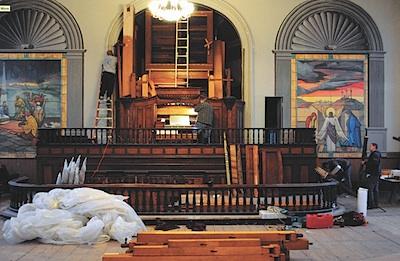Dismantling a Piece of Musical History

On a day in early January, a crew of five dedicated technicians worked painstakingly in a large, unheated, vacant church building to dismantle and save a historic pipe organ and, they hope, eventually find a new location for it.
The former Sag Harbor Methodist Church on Madison Street was the home of a pipe organ built in 1902. The instrument had served well for nearly a century, but perhaps about 10 years ago fell into disrepair.
The building was bought in November by Elizabeth Dow, a textile designer and the owner of Amagansett Applied Arts, a school that also houses a textiles and wall coverings studio. Ms. Dow’s background includes work on historic preservation and restoration projects, among them the City Opera House in Traverse City, Mich., and the Honolulu House in Marshall, Mich., and it is apparently this interest that led her to contact Elsener Organ Works in Deer Park about the instrument.
The organ, which was in the front center of the venerable and beautiful sanctuary, stands about 17 feet high, 15 feet wide, and 10 feet deep. It was built by the M.P. Moller Pipe Organ Company of Hagerstown, Md., which built about 11,000 organs between 1875 and 1992.
It has 17 sets of pipes, each with its own distinctive tone color, with a total of about 1,000 individual pipes played by two keyboards and a pedal board. They range from the size of a small pencil to perhaps 12 feet in length. Most of the pipes are made of an alloy of tin and lead, and some of them are wooden. Each pipe is actually a musical instrument in itself, working roughly on the principle of a whistle, and they are the heart of the organ sound. As is typical of the period, the facade pipes are decorated with hand-painted scrollwork.
The next day, Jan. 10, in the bare, almost eerie sanctuary, as crew members handed the pipes one by one down from the high organ loft to a table, where they were cataloged and then carefully wrapped and boxed, there was a combination of attention to detail, melancholy, and tender, loving care.
Large plastic drop cloths had been placed above the organ case to prevent the dust and debris of the surrounding reconstruction work from settling in the instrument.
JoEllen Elsener, the president of Elsener Organ Works, has led her team in dismantling, restoring, and relocating a number of similar instruments, and there are a few warehoused and waiting to find new homes, perhaps in a church, music school, or private residence.
The firm regularly tunes and maintains about 75 pipe organs of all vintages in the tristate area. It also builds, rebuilds, and restores organs, with some projects as far afield as Florida and Arizona.
“It breaks my heart,” Bill Stimpson, the firm’s shop supervisor, said. “We see it so often.” But he also spoke fondly of other similar organs that have been successfully relocated and are making music again. Sometimes such instruments are simply destroyed, but thanks to Ms. Dow this one has a good chance of being revived.
The pipes are in quite good condition and with minor repairs will be usable, as are the wind chests and the structural support. On the other hand, some of the smaller parts made of more perishable materials or that have had more wear and tear, especially those that connect the keys to the valves under the pipes, would need to be replaced. These include components made of leather, felt, and thin strips of wood.
By Jan. 11, a similar dismantling process had begun with the beautifully crafted casework made of quarter-sawn oak, and detailed photos were taken to help with the hoped-for reassembly.
Originally, the air pressure to make the pipes’ sound was provided by volunteers who hand-pumped the bellows. On the front of the casework is a water valve, indicating that the instrument was later powered by a water motor, somewhat similar to a steam engine. According to Mr. Stimpson, at that time water companies donated water to churches to power the organs.
There is, of course, a somewhat anachronistic electric switch above the keyboards, since sometime later an electric motor replaced the earlier methods of powering the bellows.
Standing there in the stark, unadorned former sanctuary, with all of its pews shoved to the rear, and watching the organ being dismantled, and the colorful murals on the walls on either side as reminders of its brighter days, one couldn’t help but wonder about a hundred years of services, happy celebrations, and sad commemorations in that space, with the beautiful, rich-toned music from that instrument, and hope that in the hands of these skilled and dedicated workers, this essentially well-built organ will sing once more. (This writer had the opportunity to play the instrument some time ago when it was in more or less playable condition.)
The remaining large parts of the wind supply, the two large wind chests and the bellows, were removed on Monday.
Soon the building will have a new incarnation. Ms. Dow, who, among her credentials, developed four wall coverings for rooms in the White House in 2009, plans to use the building for an apartment, studio, internship program, and retail space. She was recently quoted as saying, “I can’t wait to get started on this project.”
